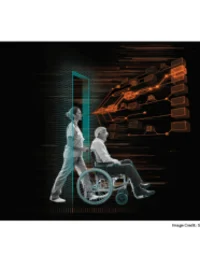
The World Health Organization labelled the Omicron variant of SARS-CoV-2 a ‘variant of concern’ because of its potential to evade immunity conferred by prior infection and the current COVID-19 vaccines. These vaccines are directed against previous versions of the spike protein, which the virus uses to enter human cells. The possibility of evading immunity exists because the variant’s spike protein has over 30 mutations which may change its structure enough to be less efficiently recognised by antibodies elicited by the current vaccines. Its current spread among vaccinated individuals supports this.
Strategies to combat the pandemic have revolved around widespread testing for infection and vaccinations. Two major obstacles now to combating the COVID-19 pandemic are:
1. The vaccines by major manufacturers offer waning immunity.
2. SARS-CoV-2 evolution may evade the immunity conferred by the current vaccines.
On the first point, the Pfizer/BioNTech COVID-19 vaccine’s effectiveness at preventing disease drops to 47% from 88% six months after the second dose (Tartof et al. 2021). Twelve months after the second dose, Moderna’s vaccine’s effectiveness drops by 36% (Puranik et al. 2021). Given that the immunity conferred by these vaccines wanes, many locales have mandated booster vaccinations as public policy. Indeed the evidence (EMA 2021, FDA 2021) has shown that booster vaccinations effectively restored immunity for Pfizer/BioNTech, Moderna, and Janssen vaccines. Even mixing and matching vaccines proved beneficial at preventing infection (Callaway 2021).
On the second point, current vaccines directed against the original wild-type may be less effective when significant mutations in the spike protein occur. For example, the two-dose Pfizer/BioNTech COVID-19 vaccine was only 50% effective against symptomatic infection from the delta variant (Desai et al. 2021). In comparison, the vaccine was 95% effective against the wild-type version of the virus (Pfizer 2021). Slow-moving vaccinations programs that provide incomplete coverage increase the likelihood that a resistant variant will evolve. Poor vaccination coverage is applying selective pressure on SARS-CoV-2 to evade vaccine-mediated immunity.
Slow-moving vaccinations programs that provide incomplete coverage increase the likelihood that a resistant variant will evolve. Poor vaccination coverage is applying selective pressure on SARS-CoV-2 to evade vaccine-mediated immunity.
Although the vaccines use the wild-type spike protein to provoke an immune response, they elicit a myriad of antibodies directed against different regions of the spike protein. Spike protein mutations render many of these antibodies ineffective, but some will continue to be effective. This is the case when neutralising antibodies directed against unmutated regions have been produced. Repeated vaccine doses elevate the production of all antibodies elicited by the wild-type spike protein, including those that can still be effective against the new variant. Thus, the vaccine and the booster can still be effective at preventing severe disease.
Boosters so far have helped provide immunity against variants, like delta. For example, when Pfizer administered a third dose of its original vaccine, a 5-fold increase was seen in antibodies effective against the delta variant compared to those generated post-dose 2 (Pfizer 2021). When Moderna administered a third dose of its original vaccine, it produced a 42-fold increase in delta-effective antibodies (Moderna 2021).
Against the Omicron variant, the vaccines are less effective at preventing symptomatic infection but can still stave off severe disease. A two-shot Pfizer/BioNTech shows only 22.5% efficacy against symptomatic infection (Cele et al. 2021). The effectiveness of the two-shot Moderna regimen is likewise reduced (Gardner and Kilpatrick 2021). According to an Israeli study (Nemet et al. 2021), Pfizer’s three-shot regimen confers significant protection, but its neutralising ability is 4X lower than for delta.
Although current vaccines are staving off severe disease, sick individuals, even while vaccinated, still transmit the virus. Partial immunity still applies selective pressure on SARS-CoV-2 to evolve and escape immunity conferred by current vaccines directed against the original wild-type. Incomplete and slow vaccination roll-out in some regions compounds this issue. Unvaccinated individuals provide a reservoir for SARS-CoV-2 to multiply and opportunities for variants to emerge. When variants appear among unvaccinated individuals within a largely vaccinated population, natural selection favours vaccine-resistant variants (Goldman 2021). Concentrating on effective and faster vaccinations and mitigation measures is key to stopping resistant mutations from developing (Wang et al. 2021).
The spike protein is a key component of SARS-CoV-2’s ability to infect human cells. Since it easily identified by the immune system, targeting it was effective for the current COVID-19 vaccines. Antibodies, recognising specific regions in the spike protein, bind it and thus neutralise the virus’s ability to enter human cells. Sadly, mutations in spike protein sites previously identified by the immune system can render these antibodies ineffective. One solution by mRNA vaccine manufacturers is to re-engineer the vaccine using a new spike protein variant. For COVID-19, Moderna bragged that it engineered the vaccine in one weekend (David Wallace-Wells 2020). Unfortunately, continuously engineering new vaccines after resistant variants develop is a poor strategy because it does not prevent new variants from arising. It is akin to developing yearly influenza vaccines.
Pursuing a malleable target like the spike protein will eventually result in resistant strains. Other less plastic viral protein targets may be available for vaccine development. Vaccine formulations that present additional viral components for the immune system to identify and attack may be able to avert resistance. This approach reduces the likelihood that the virus may mutate enough to resist a multiprong attack from the immune system.
Inactivated whole viruses are one traditional vaccine solution that offers multiple targets for the immune system to attack. But, these vaccines tend to be tricky to produce successfully. The process to scale up manufacture requires large quantities of antigen, which can be challenging to generate. Inactivation processes also often alter the virus’s immunogenicity so that antibody responses will not target live viruses. Another approach for development relies on creating multi-component vaccines that strategically target multiple proteins. Risks of adverse events increase with multiple targets, so the design must be carefully considered.
Bharat Biotech and Sinovac Biotech currently produce inactivated virus vaccines. Bharat Biotech’s vaccine shows 78% efficacy against mild, moderate, and severe disease and 70% against asymptomatic disease (Ella et al. 2021). Preliminary evidence suggests 65% efficacy against the delta variant, but further research is needed to determine the vaccine’s effectiveness against variants of concern (Ella et al. 2021). For Sinovac’s vaccine, clinical trials have reported efficacies of 51%, 65%, and 84% (Fadlyana et al. 2021; Palacios et al. 2021; Tanriover et al. 2021). Its effectiveness against the variants has yet to be determined. Thus, whether inactivated virus vaccines address the issue of SARS-CoV-2’s plasticity remains unclear.
Another approach is to target evolutionary-conserved antigenic sequences within the spike protein. The rationale is that conserved sequences resist mutation because any alteration results in a non-functional protein and, consequently, in a virus that cannot replicate. As SARS-CoV-2 continues to spawn variants, it will become evident which spike protein sequences are conserved. Computational modelling then should be able to predict which of these sequences are sufficiently antigenic to act as vaccine targets.
References:
Callaway E (2021) Mix-and-match COVID vaccines ace the effectiveness test. Nature.
Cele S et al. (2021) SARS-CoV-2 Omicron has extensive but incomplete escape of Pfizer BNT162b2 elicited neutralization and requires ACE2 for infection. medRxiv.
David Wallace-Wells (2020) We Had the Vaccine the Whole Time. New York Magazine. 7 Dec. 2020. Available from nymag.com/intelligencer/2020/12/moderna-covid-19-vaccine-design.html#comments
Desai D et al. (2021) Effectiveness of an inactivated virus-based SARS-CoV-2 vaccine, BBV152, in India: a test-negative, case-control study. Lancet Infect Dis.
Ella R et al. (2021) Efficacy, safety, and lot-to-lot immunogenicity of an inactivated SARS-CoV-2 vaccine (BBV152): interim results of a randomised, double-blind, controlled, phase 3 trial. Lancet, 398(10317), 2173-2184.
Fadlyana E et al. (2021) A phase III, observer-blind, randomized, placebo-controlled study of the efficacy, safety, and immunogenicity of SARS-CoV-2 inactivated vaccine in healthy adults aged 18–59 years: An interim analysis in Indonesia. Vaccine, 39(44), 6520-6528.
EMA (2021) EMA Press Briefing, 5 October 2021. Available from www.youtube.com/watch?v=swraoNBC7Fs
FDA (2021) U.S. Food and Drug Administration Vaccines and Related Biological Products Advisory Committee, Day 2. Available from www.youtube.com/watch?v=c-H40GrvWz4
Gardner BJ and Kilpatrick AM (2021) Estimates of reduced vaccine effectiveness against hospitalization, infection, transmission and symptomatic disease of a new SARS-CoV-2 variant, Omicron (B.1.1.529), using neutralizing antibody titers. medRxiv.
Goldman E (2021) How the unvaccinated threaten the vaccinated for COVID-19: A Darwinian perspective. Proc Natl Acad Sci U S A, 118(39), e2114279118.
Moderna (2021) Moderna Announces Submission of Initial Data to U.S. FDA for its COVID-19 Vaccine Booster. Available from investors.modernatx.com/news/news-details/2021/Moderna-Announces-Submission-of-Initial-Data-to-U-S--FDA-for-Its-COVID-19-Vaccine-Booster-09-01-2021/default.aspx
Pfizer (2021) Pfizer And BioNTech Conclude Phase 3 Study Of COVID-19 Vaccine Candidate, Meeting All Primary Efficacy Endpoints. Available from www.pfizer.com/news/press-release/press-release-detail/pfizer-and-biontech-conclude-phase-3-study-covid-19-vaccine
Pfizer (2021) Pfizer Reports, Second Quarter 2021 Results. Available from investors.pfizer.com/investor-news/press-release-details/2021/PFIZER-REPORTS-SECOND-QUARTER-2021-RESULTS/default.aspx
Puranik A et al. (2021) Comparison of two highly-effective mRNA vaccines for COVID-19 during periods of Alpha and Delta variant prevalence. medRxiv.
Tanriover MD et al. (2021) Efficacy and safety of an inactivated whole-virion SARS-CoV-2 vaccine (CoronaVac): interim results of a double-blind, randomised, placebo-controlled, phase 3 trial in Turkey. Lancet, 398(10296), 213-222.
Tartof SY et al. (2021) Effectiveness of mRNA BNT162b2 COVID-19 vaccine up to 6 months in a large integrated health system in the USA: a retrospective cohort study. Lancet, 398(10309), 1407-1416.







